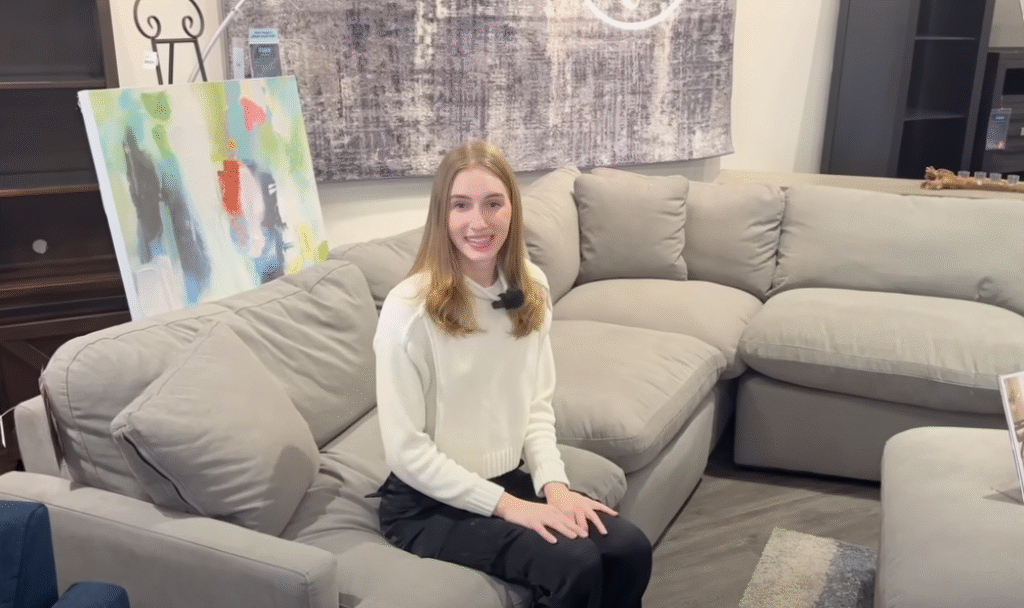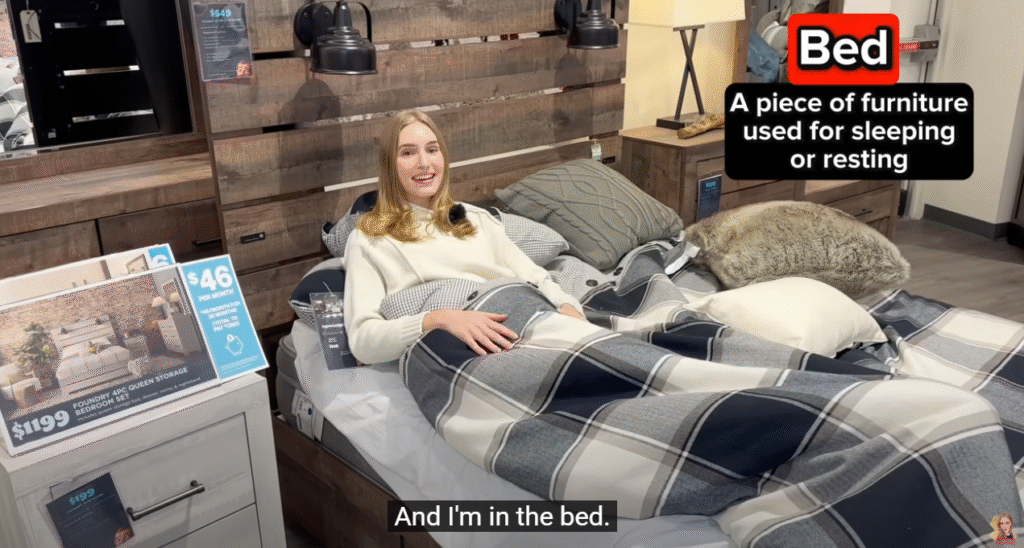Learning furniture vocabulary in English is an essential part of expanding your everyday communication skills. Whether you’re describing your home, shopping for a new chair, moving into a new apartment, or discussing design, knowing the names of furniture items will help you express yourself more clearly. This article introduces common furniture vocabulary used in homes, offices, and public places, grouped by room and function to make learning easier.

1. Living Room Furniture
The living room (also called the lounge or sitting room) is often the central area in a home for relaxation, entertainment, and socializing. Here are some common furniture items found in a living room:
- Sofa – A long, comfortable seat with a back and arms, designed for several people.
- Armchair – A chair with side supports for a person’s arms.
- Coffee table – A low table placed in front of a sofa, often used to hold drinks, books, or decorative items.
- Side table / End table – A small table placed beside a chair or sofa for holding lamps or small items.
- TV stand / Entertainment unit – A piece of furniture for holding a television and other electronic equipment.
- Bookshelf / Bookcase – A piece of furniture with shelves for storing books and other items.
- Ottoman / Footstool – A low seat or padded cushion used to rest your feet.
- Recliner – A comfortable armchair that leans back and may have a footrest that extends forward.
- Cabinet – A storage unit, often with doors, for keeping household items or electronics.
- Console table – A narrow table placed against a wall, often used for decoration.
2. Bedroom Furniture
The bedroom is a private space for sleeping, resting, and storing personal belongings. Common furniture includes:
- Bed – A piece of furniture for sleeping, usually consisting of a mattress on a frame.
- Headboard – The vertical board at the top end of a bed.
- Nightstand / Bedside table – A small table placed next to a bed, often with drawers.
- Dresser – A low, wide piece of furniture with drawers for storing clothes.
- Wardrobe / Closet – A tall cabinet or built-in space for hanging clothes and storing other items.
- Chest of drawers – A piece of furniture with several drawers stacked vertically.
- Vanity table / Dressing table – A table with a mirror, used for grooming and applying makeup.
- Mirror – Often attached to a dresser or hung on the wall, used for personal grooming.
- Blanket chest / Hope chest – A storage box placed at the foot of the bed for blankets, linens, or keepsakes.

3. Dining Room Furniture
The dining room is a space for eating meals and entertaining guests. Important furniture items include:
- Dining table – A table where people eat their meals, available in various shapes like round, square, or rectangular.
- Dining chairs – Chairs specifically designed for use at a dining table.
- Sideboard / Buffet – A low cabinet used for storing dishes, silverware, and serving food.
- China cabinet / Display cabinet – A tall cabinet with glass doors used to display fine dishes or collectibles.
- Bar cart – A small wheeled table or trolley used to serve drinks or snacks.
4. Kitchen Furniture
While kitchens are mainly equipped with appliances, some furniture may be included:
- Kitchen island – A freestanding counter often found in the center of the kitchen, used for food preparation or eating.
- Bar stool – A tall stool used at a counter or island.
- Pantry cabinet – A storage unit for food items, often with shelves and doors.
- Kitchen table – A small table used for informal meals or additional workspace.
- Breakfast nook – A small seating area, usually built into a corner, with a table for casual meals.

5. Office Furniture
An office, whether at home or in a workplace, includes functional furniture for working:
- Desk – A piece of furniture with a flat surface for writing, using a computer, or organizing work materials.
- Office chair / Swivel chair – A comfortable, often adjustable chair with wheels, designed for working at a desk.
- Filing cabinet – A tall cabinet with drawers used to store papers and documents.
- Bookcase – Similar to a bookshelf, used for storing books, files, or office supplies.
- Desk organizer – A small item or set used to keep pens, paper, and office tools in order.
- Credenza – A side cabinet often found in executive offices, used for additional storage.
6. Bathroom Furniture
While not traditionally thought of for furniture, modern bathrooms can include the following:
- Vanity unit – A combination of a sink and storage cabinet.
- Medicine cabinet – A small cupboard, usually above the sink, for storing toiletries and medicine.
- Towel rack / Towel bar – A horizontal bar for hanging towels.
- Linen cabinet – A tall, narrow cabinet used to store towels, sheets, and bathroom supplies.
- Laundry hamper – A basket or container for collecting dirty clothes.

7. Outdoor Furniture (Patio / Garden)
Outdoor or patio furniture is designed to withstand weather and be used outside:
- Patio table – A weather-resistant table used outdoors, often with an umbrella.
- Outdoor chairs – Chairs made of metal, plastic, or treated wood for use outside.
- Lounge chair / Sunbed – A reclining chair used for sunbathing or relaxing.
- Bench – A long seat for multiple people, often placed in gardens or parks.
- Swing / Hammock – Hanging furniture for relaxation outdoors.
- Deck box – A storage box for keeping cushions, garden tools, or pool supplies.
8. Furniture Materials and Styles (Bonus Vocabulary)
Understanding furniture also means knowing materials and design styles:
Common Materials:
- Wood – A traditional and durable material, often oak, pine, or mahogany.
- Metal – Used for modern, industrial-style furniture.
- Glass – Often used for tabletops and modern designs.
- Upholstery – The soft, padded fabric on sofas, chairs, or headboards.
- Leather / Faux leather – Popular for sofas and office chairs.
- Plastic / Resin – Common in outdoor or casual furniture.
Styles of Furniture:
- Modern / Contemporary – Clean lines, minimal design.
- Traditional / Classic – Ornate and formal, often made of dark wood.
- Rustic / Farmhouse – Natural finishes, warm wood tones, and country charm.
- Industrial – Raw materials like metal and wood, urban look.
- Scandinavian – Simple, clean design with light colors and functionality.

Useful English Phrases with Furniture Vocabulary
Here are some example sentences using furniture vocabulary in context:
- “I just bought a new sofa for the living room.”
- “The dining table seats eight people comfortably.”
- “He works from home at a large wooden desk.”
- “We keep our winter blankets in the blanket chest at the foot of the bed.”
- “I need to organize my papers in the filing cabinet.”
- “They have a beautiful patio set with an umbrella and four chairs.”
Conclusion
Whether you’re moving into a new home, redecorating, or just expanding your English vocabulary, knowing furniture terms can be incredibly helpful. From the bed in your room to the desk in your office, furniture vocabulary allows you to describe your surroundings and make informed choices when shopping or talking about home design.
Learning these terms is also useful when booking accommodations, visiting a furniture store, or speaking with a contractor or interior designer. The more you familiarize yourself with these words, the more confidently you can express yourself in English about your living and working spaces.
So next time you walk into a room, try naming every piece of furniture you see in English—it’s a great way to reinforce your vocabulary naturally! 🛋️🪑🛏️



